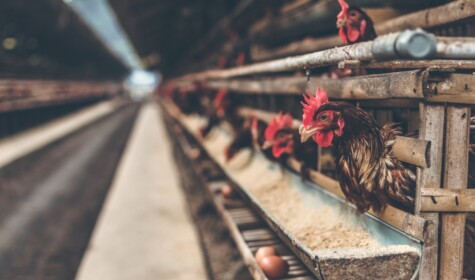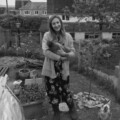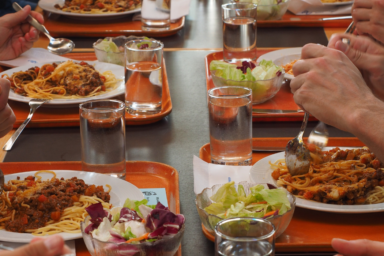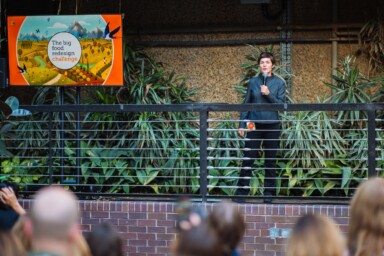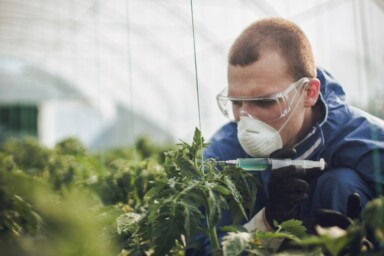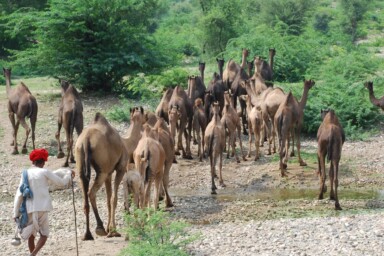A recent article argued that the way to prevent future pandemics is to intensify agriculture. Lizzie Rowe explores why this is a misguided conclusion.
The Breakthrough Institute recently published an article entitled To Combat Pandemics, Intensify Agriculture. This is the opposite conclusion to the one I made in a previously published article, and others have made as well: that intensive animal agriculture provides the perfect conditions for the emergence of zoonotic disease. So, despite being left aghast by the title alone, I was eager to read more and discover the reasoning behind this bold statement.
The article argues that ‘intensification is the solution to reducing the risk of zoonotic disease, not the problem’. It turns out that the crux of this argument is that, according to the author, intensive agriculture addresses the ‘real underlying causes of zoonosis’: land-use change and food insecurity. Let’s explore these two factors, and whether they prove that intensive agriculture is the answer.
In terms of food security, the author states that ‘the consumption of wildlife and exotic animals in China is historically rooted in food insecurity and, in fact, a failure to industrialise agriculture…a lack of resources and funding meant that the state could not supply rural farmers with the means to industrialise and take advantage of economies of scale. Farmers who could not benefit from agricultural industrialisation took up exotic animal farming as a new source of income.’
Although eating wildlife in China may have been historically rooted in food insecurity, evidence suggests consumption of wild meat in the country has moved away from subsistence and is now related to displays of wealth and status, with most wild animal meat costing more than meat from livestock.
But more to the point, the Sustainable Food Trust (SFT) makes the case that a secure food system does not necessitate intensification. In Britain, for example, the small family farms that used to exist, alongside local abattoirs, packhouses, butchers and retail outlets, formed a network of shorter more resilient supply chains that provided the infrastructure to get food to local populations in a secure and sustainable manner; and it is to this kind of food system that we need to return. This isn’t ‘pin[ing]’ for a ‘romanticised’ past, as alluded to in the last sentence of The Breakthrough’s article. In the UK, like elsewhere in the global north, the push for intensification followed two world wars; it is understandable that boosting food production through intensification was thought to be the answer to years fraught with rationing. But the pendulum swung too far. Heavy intensification, and financial incentives to do so, led us to produce more and more, cheaper and cheaper food, forming surpluses like the infamous ‘butter and beef mountains and wine lakes’. Now we have so much food that we waste shameful amounts, and consume more calories than we need, resulting in an obesity epidemic. Only by de-intensifying can we correct the pendulum’s swing, returning to a system that is better for human, animal and planetary health. In order to progress, we need to take a step back.
Of course, the picture is different in developing countries, where the problem is too few calories, not too many. Increasing efficiency and productivity in such countries is crucial and will ensure that populations have enough to eat and farmers can make a decent living. But that doesn’t necessitate intensification to the scale that we see it in the global north, with huge farms full of chemical-soaked monocultures and confined animals bred with production prioritised over welfare. Instead, less drastic approaches such as better access to and use of mineral or organic fertilisers and more productive crop varieties that are better suited to their environments and can boost food production. In terms of animal agriculture, productivity and profitability can be improved by better animal welfare, as set out by Oxford University’s Professor Marian Dawkins in her paper Animal Welfare and Efficient Farming: Is Conflict Inevitable? Conflict is not inevitable, argues Professor Dawkins, as by improving animal welfare, productivity and profitability can be increased through reduced animal mortality, improved product quality and health and disease resistance, reduced medication use, lower risk of zoonoses and foodborne diseases, and the potential to command higher prices from consumers.
Looking at the land-use angle of the argument, the author sets out that, ‘the most important factor in the development of new zoonotic diseases is land-use change. The development of wild lands, whether caused by agricultural extensification, mining or other factors, simultaneously shrinks the habitat of wildlife and brings that wildlife in close proximity to human settlements. The combination of shrinking habitats, human-wildlife interactions and food insecurity, is a recipe for zoonosis.’
I don’t dispute this point; destruction of natural habitats is undoubtedly a factor driving the spread of zoonoses. This has been covered by multiple articles.
What is disputable is the next part of the author’s argument: ‘Because the biggest driver of land-use change is agriculture, “intensive” high-yield agriculture often takes the blame, but the alternative – extensive, low-yield farming – would be worse.’ This point stems from the argument that extensive agriculture takes up more land than intensive systems to produce the same amount of food, and so eats into land that could otherwise be dedicated to wildlife. So, the author continues, ‘while monoculture means less biodiversity on farmland, the productivity gains of monocropping – and other intensive agricultural practices – allow for the sparing of far greater land that can be used as habitat for wild flora and fauna.’ This is the ‘land-sparing’ argument – that we should intensify production of food for humans into as small a space as possible, thus sparing as much land as possible for nature. The counter argument is ‘land-sharing’ – that we can produce food for humans and protect and increase biodiversity on the same land: we do not need to segregate food production and nature.
The ‘land-sharing versus land-sparing’ debate is a huge topic in itself, that I don’t have the space to do justice to in this article. But the main points I’d like to make are as follows. There is evidence that land-sharing works, for humans and nature. In the UK, you only need to look at Farm Wildlife – a collaboration between leading conservation organisations to provide best practice guidance on how to help wildlife on farmland. Their website is filled with case studies of nature thriving on food-producing farms.
In terms of scientific research, a major report by IDDRI, a French research institute for sustainable development, modelled a wholescale switch across Europe to land-sharing, nature-friendly farming practices known under the umbrella term ‘agroecology’ (farming according to an understanding of interactions between living things and their surroundings). The results revealed enough food production to feed the European population healthily and maintain export capacity, while reducing greenhouse gas emissions by 40%. In addition, the model demonstrated a recovery of microbiota in the soil and of the diversity of cultivated crops and of microfauna, with legumes encouraging pollinators and so the reestablishment of food webs, as well as varied habitats favourable to wildlife, resulting ultimately in an increase in biodiversity. These benefits to nature are in a large part due to the presence of extensively grazed livestock, which the land-sparing argument does not account for.
Finally, segregating humans from nature, as the land-sparing approach advocates, is a dangerous and damaging attitude. Seeing ourselves as separate to nature is a mindset that has led to our destruction of the natural world. We do not sit externally to nature. We are nature. We must accept this and learn to live in harmony with the natural world.
I’d also like to return to a point I made in a piece on Thoughtful Eating. We’ve got to stop setting everything out as dichotomous debates, seeing everything in terms of either/or. It may be our natural, unconscious inclination to see ourselves as tribes at war, but if we’re going to save the planet and ourselves along with it, we need to move beyond this mentality, and stop polarising our arguments. Solutions to the world’s big problems are likely to be multifaceted, rather than relying on a single approach. ‘Land-sparers’ and ‘land-sharers’ need to find middle ground with each other. We can land-share and land-spare. Not all land is suitable for production, and farmers could make money from setting aside unproductive land for nature – for example in England, through payments from the new Environmental Land Management scheme, by being rewarded for the ‘public goods’ that this land produces. This could be of huge benefit to wildlife. Ecotourism provides another economic model that shouldn’t be overlooked – take the Knepp Estate in the UK as an example, which was no longer profitable as an arable and dairy farm, but is now a hugely popular tourist destination, providing camping, ‘glamping’ and wildlife safaris that are sold out for many months in advance, as well as being a haven for some of the country’s most threatened species.
The ‘land spare versus land share’ debate fails to capture many important points that we need to turn our attention to. One is the prominence of grain-fed meat in Western diets, especially poultry. In the OECD (Organisation for Economic Co-operation and Development, an organisation of 36 countries), beef, pork and sheep meat consumption levels have varied very little between 1990 and 2017. Poultry meat consumption on the other hand has increased by 70.5%. Instead of filling their traditional role of recycling human-inedible food waste and by-products into human-edible eggs and meat, poultry are now fed grain that could directly feed humans. Reducing our consumption of grain-fed animals would reduce this ‘feed-food competition’, free up land and relieve the pressure to continue expanding the global area of farmland. We should also remember that we are not going to be able to tackle the climate crisis and save nature as long as we keep burning fossil fuels and continue with our throw-away culture. And if our population continues to grow at current rates, we won’t be able to avoid damaging the planet to the extent that it can no longer support us; the land spare versus land share debate will become obsolete.
The Breakthrough’s article fails to acknowledge why intensive farming provides the perfect breeding ground for more pandemics, not fewer – a point I’ve made before. These are, summarised briefly: compromised welfare in restrictive, intensive systems causing stress and distress, leading to immunosuppression and the emergence of infectious diseases; high stocking densities and reduced genetic diversity (‘monocultures’ of species and breeds) facilitating the rapid spread of disease; and the over- and mis-use of antibiotics encouraging the development of antibiotic-resistant bacteria (see here for a compilation of the evidence written by scientific experts).
The article argues that by driving further technological innovations, we can overcome any sustainability and biosecurity issues related to intensive agriculture. Simply put, the author concludes that ‘the only way forward is forward.’ I personally think that this is terrible advice. The only way isn’t forward if it is leading you off a cliff. And the cliff’s edge is where we are rapidly approaching when it comes to irreversible climate change and catastrophic biodiversity loss that threatens our existence just as much as any disease pandemic. Pushing forward with intensification because it’s the path we’ve already embarked on is no argument to continue in the same direction (although perhaps this mentality could be explained by the sunken cost fallacy). And as the saying goes, which is widely attributed to Einstein, ‘we cannot solve our problems with the same thinking we used when we created them’. Intensification of farming got us into this mess; it can’t get us out of it.
I’d like to end by saying that not once is the welfare of the animals in these intensive systems mentioned in The Breakthrough’s article. Should we sacrifice the well-being of farmed animals, to supposedly save wild ones? No – and nor do we need to. Science and real-world examples provide evidence for this. I for one will continue to believe in a future where we can protect the well-being of people, farmed animals and wild animals, and live in harmony, on our one shared planet.
